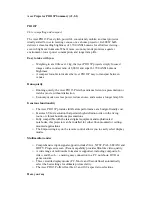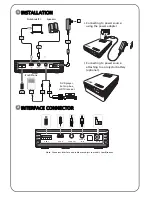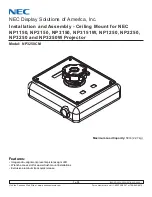
Chapter 2
Getting Started — Connecting
ENGLISH - 53
<HDMI 1 IN> terminal/<HDMI 2 IN> terminal pin assignments and signal names
Outside view
Pin No.
Signal name
Pin No.
Signal name
Even-numbered pins of
(2)
to
(18)
(1)
(19)
(2)
(18)
Odd-numbered pins of
(1)
to
(19)
(1)
T.M.D.S data 2+
(11)
T.M.D.S clock shield
(2)
T.M.D.S data 2 shield
(12)
T.M.D.S clock-
(3)
T.M.D.S data 2-
(13)
CEC
(4)
T.M.D.S data 1+
(14)
―
(5)
T.M.D.S data 1 shield
(15)
SCL
(6)
T.M.D.S data 1-
(16)
SDA
(7)
T.M.D.S data 0+
(17)
DDC/CEC
GND
(8)
T.M.D.S data 0 shield
(18)
+5 V
(9)
T.M.D.S data 0-
(19)
Hot plug detection
(10)
T.M.D.S clock+
Connecting example: AV equipment
Audio device
VCR
(with built-in TBC)
Blu-ray disc player
Attention
f
Be sure to use one of the following when connecting a VCR.
g
Use a VCR with built-in time base corrector (TBC).
g
Use a time base corrector (TBC) between the projector and the VCR.
f
The image may be disrupted when nonstandard burst signal is connected. In such a case, connect the time base corrector (TBC) between
the projector and the external devices.
Note
f
For the HDMI cable, use an HDMI High Speed cable that conforms to the HDMI standards. If a cable that does not conform to the HDMI
standards is used, images may be interrupted or may not be projected.
f
The <HDMI 1 IN>/<HDMI 2 IN> terminals can be connected to an external device with the DVI-D terminal by using an HDMI/DVI conversion
cable. However, this may not function properly for some external devices, and image may not be projected.
f
The projector does not support VIERA Link (HDMI).
















































